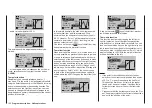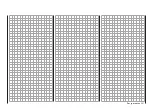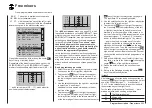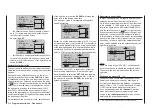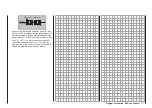
204 General notes on freely programmable mixers
The previous pages have described a wealth of
ready-to-use built-in coupling functions, in the context
of the two menus »Wing mixers« and »Helicopter
mixers«. The fundamental significance of mixers and
the principle by which they work are described on
page 169. The following section provides information
about the so-called “free mixers”.
In addition to the pre-programmed mixers mentioned
above, the transmitters
mc-16
HoTT and
mc-20
HoTT also offers a number of freely programmable
mixers in every model memory location, whose in-
puts, outputs and mixer ratios can be defined to meet
one’s own requirements. These include:
• 8 linear mixers, numbered 1 through 8
• 4 curve mixers, numbered 9 through 12
These 12 mixers are certainly adequate for most
applications and are certainly sufficient when the
potential of the pre-programmed coupling functions
are utilized. The »MIX act. / phase« menu, which is
available as standard on the
mc-20
HoTT trans-
mitter only, see page 215, also provides a means
of activating or disabling any of these twelve mixers
separately for each flight phase.
For the “free mixers”, the signal present at any control
function (1 to 8 or 1 … 12) can be assigned as the
input signal or, for a so-called “switch channel” (see
further below), the signal from any switch can be uti-
lized. The signal that is present at the control channel
and passed to the mixer input is always influenced by
its own transmitter control and by any control charac-
teristic that may have been set, e. g. those specified
by the »Dual Rate / Expo«, »Channel 1 curve« and
»Control adjust« menus.
The mixer output acts on a control channel (1 to – de-
pending on transmitter and receiver type – a maxi-
mum of 12) that can also be assigned freely. Before
this channel routes the signal to the servo, it can only
still be influenced by the »Servo adjustment« menu,
i. e. by the servo reverse, neutral point offset, servo
travel and servo travel limit functions, and possibly by
the »Tx. output swap« option, which is available as
standard on the
mc-20
HoTT transmitter only, but
can be unlocked on the
mc-16
HoTT transmitter as
an extra-cost option.
One control function can be used for any number of
mix inputs simultaneously: if, for example, several
mixers are to be switched to act in parallel.
Conversely, it is possible for any number of mixers to
affect one and the same control channel. Particularly
in the latter case, however, it is very important to
ensure that the servo concerned does not strike its
mechanical end-stops when several mixer signals ac-
cumulate excessively. For safety’s sake, it may there-
fore be necessary to set an appropriate travel limit in
the »Servo adjustment« menu, page 112.
For more complex applications, mixers can be
switched in sequence. In this case, it is not the
(transmitter) signal at the “output” of a control func-
tion which forms the input signal of the “series-wired”
mixer, but the (mixed) signal “further back” at the “in-
put” of a control channel. The following description of
the free mixers includes several examples of this type.
In the software, a “free mixer” is always initially acti-
vated. Optionally the mixer can also be assigned to
an ON/OFF switch. Since there are so many func-
tions to which switches can be assigned, be careful
to avoid (undesired) multiple assignments to a single
switch.
The two key mixer parameters are:
• … the mixer ratio, which defines the extent to
which the input signal acts on the output of the
control channel connected to the mixer output.
The mixer ratio for linear mixers can be set as
symmetrical or asymmetric. Curve mixers can also
be configured with up to 6 points to suit one’s own
application and even implement extremely non-lin-
ear curves.
• … the neutral point of a mixer, which is also
referred to as the “offset”.
The offset is that specific point along the move-
ment of a transmitter control (stick, proportional
control or switch) at which the mixer no longer in-
fluences the control channel connected to its out-
put. Normally, the neutral point is the center point
of the transmitter control. However, the offset can
also be set at any other point along the control
travel. Since there are no restrictions on the de-
sign of the curve mixers, setting a mixer neutral
point only makes sense for the 8 linear mixers.
Switch channel “S” as a mixer input
Occasionally, however, only a constant control sig-
nal is required at the mixer output, e. g. for a slightly
increased “up-elevator” trim when the aero-tow re-
lease is closed – fully independently of its normal trim
setting.
In this case a switch is assigned both to the aero-tow
release and the mixer; it is then used not only to open
and close the release, but also to pass the desired
trim signal to the elevator via the mixer ratio. To iden-
tify this special arrangement, this mixer input control
function in the program is designated “S” for “Switch
channel”.
In addition, if the corresponding “target channel”
should now no longer be influenced by its “normal”
transmitter control, separate its transmitter control
from the function input of the associated control
channel in the »Mix-only channel«, see page 216,
which is available as standard on the
mc-20
HoTT
transmitter only. Here too, for clarification of this there
is an example of the function provided in the following
menu description.
General notes on freely programmable mixers
Summary of Contents for HoTT MC-16 Series
Page 1: ...Programming Manual mc 16 mc 20 HoTT 1 en mc 16 mc 20...
Page 27: ...27 For your notes...
Page 53: ...53 For your notes...
Page 61: ...61 For your notes...
Page 65: ...65 For your notes...
Page 71: ...71 For your notes...
Page 103: ...103 For your notes...
Page 107: ...107 For your notes...
Page 111: ...111 For your notes...
Page 155: ...155 For your notes...
Page 165: ...165 For your notes...
Page 201: ...201 For your notes...
Page 229: ...229 For your notes...
Page 231: ...231 For your notes...
Page 261: ...261 For your notes...
Page 265: ...265 For your notes...
Page 301: ...301 For your notes...
Page 327: ...327 For your notes...
Page 328: ...328 For your notes...

